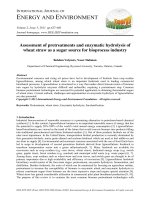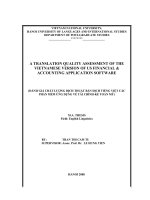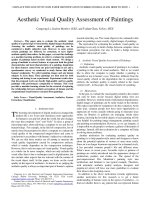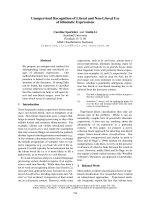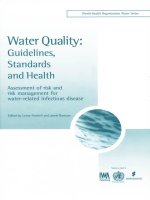Grain quality assessment of scented and non scented rice varieties under organic nutrient management
Bạn đang xem bản rút gọn của tài liệu. Xem và tải ngay bản đầy đủ của tài liệu tại đây (226.51 KB, 8 trang )
Int.J.Curr.Microbiol.App.Sci (2019) 8(9): 775-782
International Journal of Current Microbiology and Applied Sciences
ISSN: 2319-7706 Volume 8 Number 09 (2019)
Journal homepage:
Original Research Article
/>
Grain Quality Assessment of Scented and Non Scented Rice Varieties under
Organic Nutrient Management
Mahendra Anjna1*, V. K. Shukla1, S. S. Shukla2 and Shivam Gour3
1
Department of Agronomy, College of Agriculture Jabalpur, Jawaharlal Nehru Krishi Vishwa
Vidyalaya, Jabalpur (MP) – 482004, India
2
Department of Food Science and Technology, JNKVV, Jabalpur (MP), India
3
College Of Agriculture Indore, Rajmata Vijayaraje Scindia Krishi Vishwavidyalaya,
Gwalior, (MP)-452001, India
*Corresponding author
ABSTRACT
Keywords
Physico-chemical,
Milled rice,
Hulling, Alkali
spreading value
Scented Rice and
Non-scented rice.
Article Info
Accepted:
12 August 2019
Available Online:
10 September 2019
Global demand for organically grown foods is increasing and organic
agriculture is growing fast in recent years. Organic farming encourages the
reduction of agrochemicals and promotes soil conservation principles. Field
experiment was conducted at Krishi Nagar, Research Farm, Jawaharlal
Nehru Krishi Vishwa Vidyalaya, Jabalpur (MP) during kharif season 2018.
Experiment was carried out using randomized complete block design
involving twelve scented and non scented rice (Oryza sativa L.) varieties
with three replications. An improved scented varieties viz., Pusa Sugandha
5, Pusa Sugandha 4, Pusa Sugandha 3, Pusa Basmati 1, Madhumati &
Sahyadri and non scented varieties viz., BVD 109, JR 201, Dhanteshwari,
IR 36, MTU 1010 & IR 64 were included as a test variety. A uniform dose
of organic manures i.e. 1/3rd Nitrogen through each of Farm yard manure,
Neem cake and Vermicompost were applied to all the varieties. Results of
the study revealed that Pusa Sugandha 3 has recorded significantly higher
grain yield (3298 kg ha-1) among all the varieties. Pusa Sugandha 5
recorded maximum Physico-chemical quality parameters viz., Paddy
length- breadth ratio (5.21), Milled rice L: B ratio (7.23), Hulling per cent
(76.80%), Milling per cent (67.90%), Head Rice Recovery (59.94%),
Alkali spreading value (6.67) and Elongation ratio (1.95) fallowed by Pusa
Sugandha 4 and Pusa Sugandha 3. The minimum grain quality parameters
were recorded in non scented rice varieties.
775
Int.J.Curr.Microbiol.App.Sci (2019) 8(9): 775-782
wise swelling, intensity of aroma, fluffiness,
palatability and longer shelf life. Scented rice
has a special place in the world rice market
and is generally the highest priced rice
(Efferson, 1985). Aromatic rice has great
potential to attract rice consumer for its taste
and deliciousness, and high price to boost up
the economic condition of the rice grower in
the country. Because of its natural chemical
compounds which give it a distinctive scent or
aroma when cooked, aromatic rice commands
a higher price than non- aromatic rice. (Singh
et al., 2001). Kernel shape and L/B ratio are
important features for grain quality assessment
(Rita and Sarawgi, 2008). Aroma, hardness
and roughness are depends on temperature and
variety specific which affects the sensory
properties of cooked rice (Yau and Huang,
1996) The present investigation was therefore,
undertaken to Grain quality assessment of
scented and non scented rice varieties under
organic nutrient management.
Introduction
Rice (Oryza sativa L.) is one of the most
important cereal crops of the world, grown in
different areas over the world. It is grown in
more than hundred countries, with a total area
of 158 million hectares, producing more than
700 million tonnes (MT) annually. India is not
only a leading consumer of rice crop but also
its second largest producer in the world
(115.60 million tonnes), lagging behind only
China. In India total area under rice
cultivation is 43.86 million ha. and rice is
grown in almost half the states, with West
Bengal leading the way in terms of production
with 15.75 million tonnes, followed by Uttar
Pradesh (12.22 million tonnes) and Punjab
(11.57 million tonnes) as per the Agricultural
Statistics 2018-19, Ministry of Agriculture &
Farmers Welfare of the Government of India.
In Madhya Pradesh, rice is grown in around
2.02 million ha area with the production of
3.58 MT and with average yield of 1768 kg/ha
(Agriculture research data book, 2017). India
has earned more than Rs 18,000 crore foreign
exchange per year from the export of basmati
rice; especially from the variety Basmati rice
developed by the country's top agri-institute
ICAR. Organic farming is gaining momentum
during recent times due to awareness of
people towards environment and food safety.
Production of high quality organic aromatic
rice by the farmers for domestic as well as
export purpose is a major concern of future
agricultural strategy. Organic food markets in
India are expanding quite fast owing to
growing demand for organic food and the high
premium it fetches (Patnaik, 1996). Basmati
and fine grain aromatic rice have tremendous
export value. Organic and inorganic produce
differ in quality parameters (Artur and
Kjellenberg, 1997; Bourn and Prescott, 2002;
Wszelaki et al., 2005). Basmati rice
commands high premium in market due to its
exclusive nature and quality traits such as
linear kernel elongation with least breadth-
Materials and Methods
776
The experiment was conducted at Krishi
Nagar, Research Farm, Jawaharlal Nehru
Krishi Vishwa Vidyalaya, Jabalpur (MP)
during kharif season 2018. The soil of the
experimental site was neutral in reaction (pH
7.27) with normal EC (0.36 dS m-1), medium
in OC contents (0.84%), low in available N
(267.83 kg ha-1), medium in available P (12.96
kg ha-1), and medium in available K (300.03
kg ha-1) contents. The rainfall was less
1092.10 mm and other weather conditions
were normal for better growth and
development of the crop. The treatments
consisted of twelve varieties of rice were
divided into two groups scented and non
scented. Scented varieties viz., Pusa Sugandha
5, Pusa Sugandha 4, Pusa Sugandha 3, Pusa
Basmati 1, Madhumati & Sahyadri and non
scented varieties viz., BVD 109, JR 201,
Dhanteshwari, IR 36, MTU 1010 & IR 64
were tested in randomized block design with
Int.J.Curr.Microbiol.App.Sci (2019) 8(9): 775-782
three replications. A uniform dose of organic
manures i.e. 1/3rd N through each of FYM,
Neem cake and Vermicompost and rock
phosphate were applied to all varieties.
Organic manures were applied based on their
nutrient content and incorporated two weeks
before planting. Twenty days old seedlings
were transplanted on 10th July 2018 by using
of two seedlings per hill with the planting
geometry of 20 cm x 20 cm. Weeds were
controlled by two hands weeding at 20 and 40
days
after
transplanting
(DAT).Yield
parameters were recorded along with grain
and straw yield. Quality tests of grain viz.,
length and breadth of paddy, brown rice and
milled rice, hulling, milling and head recovery
were done by using a composite sample in
thrice replication. The observations were
recorded and techniques were employed in
present investigation are summarized as
under:
Milling percentage
The length and breadth of ten randomly
selected paddy, brown rice and milled rice
kernels were measured with the help of a
graph paper or screw gauge. Average of
length and breadth was taken in millimeters
and Length- Breadth ratio (L: B ratio) was
calculated (Dela Cruz and Khush, 2000).
Aroma content was estimated by using
method developed by IRRI (1971) and
subsequently improved by Sood and Siddiq
(1978).
=
Head rice recovery percentage
After milling the whole and broken grains
were separated. The per cent of head rice or
unbroken rice grain were determined based on
the initial weight of the rough rice per cent of
total rice or sum total of head rice and all
classes of broken rice. The formula is as
follow
Head rice recovery percentage
=
Determination of aroma
Hulling percentage
The method consists of adding about 10 ml of
1.7 per cent potassium hydroxide solution to a
small petri plate containing about 2 g finely
minced sample of grain. Then petri plates are
covered immediately after addition of alkali
and left at room temperature for about 10
minutes. The plates are then opened and the
contents smelled. The samples possessing the
scent as one could easily feel, produce a sharp
and readily recognizable aroma.
SS = strongly scented; MS = mild scented; NS
= non scented
The mud lumps, rice stems, leaves and other
foreign matter from the sample were removed
and then 100 g of grain sample was weighed.
The clean sample was shelled with the Satake
Sheller. The samples were hulled and weights
of de-hulled grains were recorded. The
formula is as follows Hulling percentage=
Milling percentage
Alkali spreading
temperature)
The hulled samples were milled and weight of
milled grains was recorded. The formula is as
follow;
The Gelatinization temperature was measured
in terms of alkali disintegration using a (7)
point numerical spreading scale as suggested
777
value
(Gelatinization
Int.J.Curr.Microbiol.App.Sci (2019) 8(9): 775-782
by Little et al., (1958). Six milled rice kernels
were evenly placed in Petridis containing 1.7
per cent 10 ml KOH solution at 30 ±1°C for
23 hours and the scoring was recorded.
lowest L: B ratio (2.33) was calculated under
variety JR 201.
The length and breadth of dehulled rice of all
the varieties were measured (Table 1) and
brown rice length ranged from 8.53 to 5.63
mm. Brown rice L: B ratio of different rice
varieties greatly varied from 4.59 to 2.37.
Elongation ratio
Elongation ratio (ER) of cooked kernels was
determined by dividing the length of cooked
kernel to length of uncooked kernel (Juliano
and Betchel, 1985). This was calculated by the
following formula:
Elongation ratio
The length and breadth of white rice (milled
rice) of all the varieties were measured, length
ranged from 7.23 to 4.87 mm amongst the
varieties. The significantly highest milled rice
length (7.23 mm) measured in the Pusa
Sugandha 5 which was significantly superior
over other varieties of rice except Pusa
Sugandha 4 and Pusa Sugandha 3. The lowest
milled rice length (4.87 mm) was measured
for the variety JR 201. L: B ratio of different
milled rice varieties greatly varied from 4.16
to 2.25 with highest value (4.16) for Pusa
Sugandha 5 which was at par with Pusa
Sugandha 4 (3.92) and Pusa Sugandha 3
(3.77). The lowest value of milled rice L: B
ratio was calculated in JR 201 (2.25).
=
Data collected and recorded from various
observations were tabulated and subjected to
their statistical analysis as per the procedure
suggested by Panse and Sukhatme (1967).
Results and Discussion
Data pertaining to grain quality parameters
were presented in table 1. Among the different
varieties, paddy length was widely ranged
from 12.33 to 6.33 mm. The significantly
highest paddy length (12.33 mm) measured in
the Pusa Sugandha 5 which was significantly
superior over other varieties of rice. The
lowest paddy length (6.33 mm) was measured
for the variety JR 201. Paddy breadth of rice
varieties there were no significant difference
among the all varieties. Paddy length- breadth
ratio (L: B ratio) varied significantly for
different rice varieties and ranged from 5.21 to
2.33. Pusa Sugandha 5 calculated significantly
highest L: B ratio (5.21) which was at par with
Pusa Sugandha 4 and Pusa Sugandha 3. The
Data on hulling percentage are presented in
table 2. All the varieties had average 72.90
(%) hulling percent and ranged from 76.80 to
66.63 per cent for different rice varieties. The
highest hulling percentage was calculated in
Pusa Sugandha 5 (76.80%) which was at par
with Pusa Sugandha 4, Pusa Sugandha 3,
Dhanteshwari, Madhumati and Pusa Basmati
1.
778
The lowest hulling percentage was calculated
in Sahyadri (66.63%). Variation in hulling
percentage may be due to differences in
genetic potential and moisture content. Similar
findings have also been reported by Subudhi
et al., (2012).
Int.J.Curr.Microbiol.App.Sci (2019) 8(9): 775-782
Table.1 Physical quality parameters of scented and non scented rice varieties under organic nutrient management
Paddy grain
Breadth
(mm)
2.37
Brown rice
Length
Breadth
(mm)
(mm)
8.53
1.87
Milled rice
Length Breadth
(mm)
(mm)
7.23
1.75
T. No.
Varieties
T1
Pusa Sugandha 5
Length
(mm)
12.33
T2
Sahyadri
7.47
2.33
3.21
6.03
2.03
3.01
5.17
1.85
2.84
T3
Pusa Sugandha 4
11.50
2.38
4.84
7.83
1.87
4.20
6.83
1.75
3.92
T4
BVD 109
8.00
2.37
3.39
6.57
2.00
3.32
5.63
1.82
3.13
T5
JR 201
6.33
2.73
2.33
5.63
2.37
2.37
4.87
2.19
2.25
T6
Dhanteshwari
7.27
2.13
3.40
6.60
1.90
3.47
5.63
1.72
3.27
T7
Madhumati
8.00
2.40
3.34
7.27
2.03
3.57
6.43
1.85
3.47
T8
IR 36
7.33
2.30
3.19
6.13
2.00
3.07
5.20
1.84
2.83
T9
MTU 1010
8.23
2.27
3.64
6.83
2.00
3.43
6.30
1.84
3.43
T10
IR 64
8.00
2.40
3.34
6.33
2.07
3.06
5.40
1.89
2.86
T11
Pusa Basmati 1
8.33
2.40
3.55
7.27
2.07
3.55
6.23
1.95
3.22
T12
Pusa Sugandha 3
SEm±
11.33
0.47
2.38
0.11
4.78
0.27
7.72
0.29
1.89
0.09
4.08
0.20
6.67
0.26
1.77
0.09
3.77
0.18
CD (P=0.05)
1.39
-
0.79
0.85
-
0.59
0.77
-
0.53
L: B
ratio
5.21
779
L: B
ratio
4.59
L: B
ratio
4.16
Int.J.Curr.Microbiol.App.Sci (2019) 8(9): 775-782
Table.2 Physico-chemical parameters of scented and non scented rice varieties under organic nutrient management
T.No.
Varieties
Hulling
(%)
Milling (%)
Head rice
recovery (%)
Alkali
spreading
value
Elongation
ratio
Grain yield
(kg ha-1)
T1
Pusa Sugandha 5
76.80
67.90
59.94
6.67
1.95
3082
T2
Sahyadri
66.63
59.31
51.82
4.67
1.78
2691
T3
Pusa Sugandha 4
75.73
67.39
56.99
5.67
1.94
2986
T4
BVD 109
67.13
64.39
51.66
4.67
1.77
2916
T5
JR 201
71.17
63.71
52.63
4.33
1.74
2750
T6
Dhanteshwari
75.10
60.07
53.66
1.33
1.74
2796
T7
Madhumati
75.03
65.14
52.46
1.67
1.80
2535
T8
IR 36
71.13
64.02
48.64
2.00
1.51
2774
T9
MTU 1010
73.80
62.92
52.05
1.67
1.68
2845
T10
IR 64
72.57
62.91
49.07
1.67
1.44
2786
T11
Pusa Basmati 1
74.27
63.98
52.24
5.67
1.74
2823
T12
Pusa Sugandha 3
75.40
66.69
54.06
4.67
1.81
3298
1.20
0.12
1.45
0.33
0.07
37.23
3.53
0.36
4.26
0.98
0.19
109.74
SEm±
CD (P=0.05)
780
Int.J.Curr.Microbiol.App.Sci (2019) 8(9): 775-782
Milling percent of all rice varieties (Table 2)
differed significantly and ranged between
67.90(%) to 59.31(%) among the varieties.
Significantly highest milling percentage was
calculated in Pusa Sugandha 5 (67.90%)
followed by Pusa Sugandha 4.
It ranged from 1.33 to 6.67. Pusa Sugandha 5
scored the highest alkali spreading value
(6.67) which was found to be significantly
superior over rest of the varieties except Pusa
Sugandha 4 and Pusa Sugandha 3.
All the twelve rice varieties significantly
varied with each other in length and breadth of
rice kernel after cooking. Elongation ratio of
different rice varieties (Table 2) ranged from
1.44 to 1.95. Pusa Sugandha 5 calculated the
highest elongation ratio (1.95) closely
followed by Pusa Sugandha 4, Pusa Sugandha
3 and Madhumati. The least elongation ratio
was calculated in IR 64 (1.44) which was
comparable with IR 36 (1.51). The results of
the present investigation unveil that evolved
scented varieties were better than non scented
varieties. Pusa Sugandha 3 proved better as
compared to Pusa Sugandha 5 and Pusa
Sugandha 4 especially in terms of grain yield.
Pusa Sugandha 5 and Pusa Sugandha 4
varieties were mostly superior in quality
parameters to non scented varieties. Hence,
using easily available local natural resources,
organic farming can be practiced with a view
to protect/preserve/safe guard our own natural
resources and environment for a fertile soil,
healthy crop and quality food and let our
future generations enjoy the benefits of nonchemical agriculture.
The lowest milling percentage was calculated
in Sahyadri (59.31%). The head rice recovery
of the varieties was calculated in table 2 and it
was clear that all the rice varieties showed a
significant difference with each other in terms
of head rice recovery.
Maximum head rice recovery (59.94%) was
calculated in Pusa Sugandha 5 whereas
minimum head rice recovery calculated in IR
36 (48.64%).
Variation in head rice recovery in different
varieties is closely related with moisture
content and force of the milling machine.
Similar results were recorded by Babu et al.,
(2013).
Aroma in rice was influenced by genetic
character of variety and it is a very important
character judging rice quality around the
world. Characteristics pertaining to aroma in
rice quality of scented rice varieties it was
observed that only three varieties are strongly
scented class of aroma and those were Pusa
Sugandha 5, Pusa Sugandha 4 along with Pusa
Sugandha 3, three varieties are mildly scented
viz., Pusa Basmati1, Madhumati and Sahyadri
whereas, rest of the rice varieties were found
to be non scented viz., BVD 109, JR 201,
Dhanteshwari, MTU 1010, IR 64 and IR 36.
Nadaf et al., 2007 reported that Basmati rice
contains more aroma than the traditionally
cultivated scented rice varieties.
References
Gelatinization temperature (GT) of rice is
measured in terms of alkali spreading value
(ASV). The data on alkali spreading value are
presented in Table 2.
Agriculture research data book. 2017. ICARIndian Agricultural Statistics Research
Institute (IASRI) New Delhi. 177-178
p.
Bajpai A, Singh Yogendra (2010). Study of
quality characteristics of some small
and medium grained aromatic rice of
Uttar Pradesh and Uttarakhand.
Agric.Sci.Digest. 30 (04): 241-245
Banerjee S, Ghosh M, Pal SK, Mazumdar D
and Mahata D. 2015. Effect of organic
nutrient management practices on
781
Int.J.Curr.Microbiol.App.Sci (2019) 8(9): 775-782
yield and economics of scented rice
gobindabhog.Oryza 50(4) 365-369.
Bhonsle SJ and Mondal SS. 2010. Grain
quality Evalution and organoleptic
analysis of aromatic rice varieties of
Goa, India. Journal of Agriculture
Sciences (Toronto), 2 (3): 99-107.
24ref.
Bhattacharya KR and Sowbhagya CM. 1972.
Evaluation of alkali spreading value in
rice. Cereal Sci. Today. 16: 420 – 424.
Davari MS and Sharma SN. 2010. Effect of
different combination of organic
materials
and
biofertilizerson
productivity, grain quality and
economics in organic farming of
basmati (Oryza sativa). Indian Journal
of Agronomy 55(3): 290-294.
Delacruz NM and Khush GS. 2000. Rice grain
quality evaluation procedures. In:
Aromatic Rices (Singh R K, Singh U
S, and Khush G S, Eds.). Oxford &
IBH Publishing Co, New Delhi. 15-28.
Efferson JN. 1985. Rice quality in world
markets. In: Grain quality and
marketing. Paper presented at the
International
Rice
Research
Conference, 1-5 June 1985. p 1- 29.
Jennings PR, Coffman WR, Kauffman HE.
1979. Grain quality. In: Rice
improvement.
Juliano BO, Bautista GM, Lugay JC, Reyes
AC.
1964.
Studies
on
the
physicochemical properties of rice. J.
Agric. Food Chem. 12:131-138.
Khush GS, Paule CM, de la Cruz NM. 1979.
Rice grain quality evaluation and
improvement at IRRI. In:Proceedings
of Workshop on Chemical Aspects of
Rice Grain Quality. Los Baños
(Philippines):
International
Rice
Research Institute. p 22-31.
Los Baños (Philippines): International Rice
Research Institute. p 101-120.
Little RR, Hilder GB, Dawson EH. 1958.
Differential effect of dilute alkali on
25 varieties of milled white rice.Cereal
Chem. 35:111-126.
Nene YL. 1998. Basmati rice: a distinct
variety (cultivar) of the Indian
subcontinent. Asian-Agri-History, 2
(3): 175-188.
Shilpa J. 2010. Grain Quality Evaluation and
Organoleptic Analysis of Aromatic
Rice Varieties of Goa, India. Journal
of Agricultural Science Vol. 2, No. 3
Singh V, Singh AK, Mohapatra T, Krishnan
GS and Ellur RK. 2018. Pusa Basmati
1121 – a rice variety with exceptional
kernel
elongation
and
volume
expansion after cooking. Journal of
Agricultural Science 11:19
Sood BC and Siddiq EA. 1978. A rapid
technique forscent determination in
rice. Indian J. Genet. Plant Breed. 38:
268-271
Singh SK, Varma SC, Singh RP. 2001. Effect
of integrated nutrient supply on
growth, yield, nutrient uptake,
economics and soil fertility in irrigated
rice. Oryza. 2001; 38(1&2):56-60.
How to cite this article:
Mahendra Anjna, V. K. Shukla, S. S. Shukla and Shivam Gour 2019. Grain Quality
Assessment of Scented and Non Scented Rice Varieties under Organic Nutrient Management.
Int.J.Curr.Microbiol.App.Sci. 8(09): 775-782. doi: />
782

